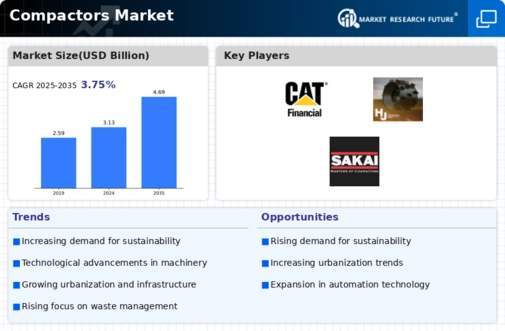Top Industry Leaders in the Compactors Market

Beyond curbside recycling bins, a hidden war of compression unfolds. From towering industrial machines to discreet under-counter kitchen helpers, compactors play a crucial role in waste management, but beneath their steel exteriors lies a battle royale where established titans duke it out with nimble niche players, all vying for a chunk of the compressed garbage pie. Let's delve into the strategies, trends, and recent developments shaping this fascinating, and surprisingly dynamic, landscape.
Strategies Crushing the Competition:
-
Diversification Beyond the Bin: Leading companies like Wastequip and American Baler Company are expanding their portfolios beyond traditional trash compactors, venturing into industrial balers, waste-to-energy systems, and even mobile compaction units, catering to diverse waste management needs. -
Sustainability Spotlight: Green credentials are the new landfill permit. Mil-tek International is leading the charge by developing energy-efficient and recyclable compactor models, aligning with environmental regulations and attracting eco-conscious consumers. -
Technological Twists: Innovation fuels the crushing force. Eco Green Equipment is pioneering solar-powered compactors for off-grid locations, offering sustainable waste management solutions in remote areas. -
Smart Waste Warriors: Technology meets trash. Keter Ltd. is integrating smart features into home compactors, like automatic alerts for full bins and app-controlled compaction cycles, transforming them into connected waste management hubs. -
Geographic Prowess: Emerging markets like China and India present fertile ground for growth. Doosan Infracore, for instance, has strategically established production facilities in these regions to capitalize on the surging demand for affordable and efficient compactors.
Factors Shaping Market Share:
-
Compactor Type Matters: Different types cater to distinct needs. Large industrial balers dominate waste processing facilities due to their high capacity, while under-counter kitchen compactors find application in residential waste reduction. Harris Waste Handling excels at tailoring compactor capacities and functionalities to specific waste streams. -
Regional Regulations: Waste management policies and landfill limitations influence market dynamics. The European Union's Landfill Directive, for example, incentivizes waste compaction and recycling, boosting demand for efficient compactor solutions. -
Cost Competitiveness: Price remains a crucial factor, particularly for small businesses and residential purchases. Asian manufacturers often offer cost-effective options, while European and American players command premium prices for high-performance, technologically advanced compactors. Wittke Maschinenbau focuses on balancing affordability with quality and durability. -
Technological Advancements: New material handling systems, automated loading capabilities, and even AI-powered waste sorting features can disrupt the market. AMP Robotics, for instance, is developing robotic arms for industrial compactors, improving safety and efficiency in waste processing. -
Focus on Hygiene and Safety: Concerns about odor control, bacteria build-up, and potential injury during operation influence consumer preferences. Wastequip is leading the way by incorporating antimicrobial coatings, self-cleaning mechanisms, and safety sensors into its compactor models.
Key Players:
- Terra Compactor Wheel Corporation
- Caterpillar Inc.
- BOMAG GmbH
- Marcel Equipment Limited
- HJ Industries
- Humdinger Equipment Ltd.
- G. Compactors Limited
- Hamm AG
- Sakai America
- MBW Incorporated
Recent Developments:
August: Mil-tek International unveils a line of solar-powered compactors ideal for remote locations, attracting eco-conscious communities and off-grid businesses.
September: The European Union proposes stricter regulations on landfill waste diversion, prompting businesses and municipalities to invest in advanced compactors and waste processing solutions.
October: China announces a major infrastructure development plan, including waste management upgrades, boosting demand for high-capacity industrial compactors.
November: A consortium of compactor manufacturers and waste management organizations launches a research initiative to develop standardized performance protocols and recycling guidelines for compacted waste, promoting responsible waste management practices.
December: A promising startup develops a bio-based coating for compactor bins that neutralizes bacteria and prevents odor build-up, potentially changing hygiene standards in waste collection and processing.

